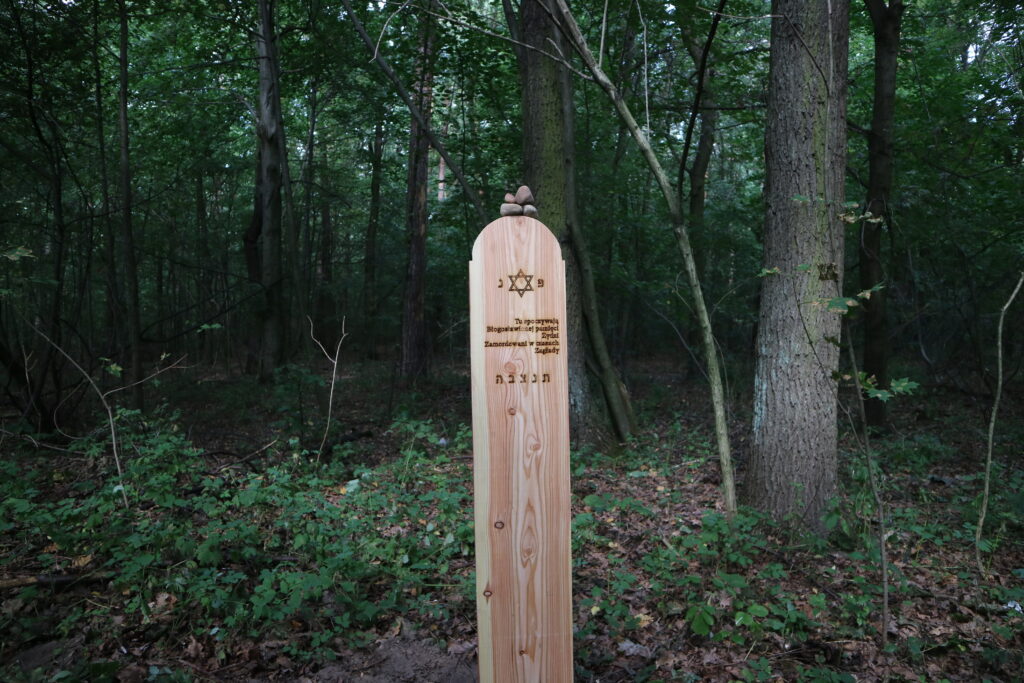Adampol Slave Labour/Death Camp, Poland
"We never had the opportunity to lay a flower for any of our beloved ones who died here. But we will mourn them today. Their souls in heaven will always be with us.""He [his father Jack Pomeranc] had tremendous anxiety and regrets and fear. [He was] crying and apologizing to his family that he wished he [had] saved them, and he could have but he didn't and should have.""And at that time, I understood very well that this was something I needed to put closure to for him, since he was traumatized all his life from it."Today we bring closure to this chapter in our lives."Michael Pomeranc, son of Holocaust survivor

After
many long years of planning, Michael Pomeranc and his close relatives
fulfilled a personal mission when they took part in a ceremony to unveil
memorials to murdered Jews during the Second World War. The venue was a
forest in Poland. And the memorial was to honour the Jews murdered by
German forces. Dozens of Michael Pomeranc's relatives among them, at a
little-known German labour camp named Adampol.
During
the dedication ceremony, Pomeranc spoke of his childhood in the United
States. Where there were no cemeteries that held the remains of his
family members, no graves to visit that held the remains of his
predecessors in his family tree. Jews were forced to work as slave
labourers in fields nearby the Nazi labour camp. Once their usefulness
was over, when they became too weak, too ill to continue labouring, they
were murdered, in 1943.
Poland,
under Nazi German occupation, was the site of many such labour and
death camps where Jews had value as slave labourers and when they could
no longer perform the labours assigned to them they were scheduled for
mass extermination in the death camps. Auschwitz is the most well-known
of all such death camps, but it was only one of many, although it was
responsible for the extermination of over a million Jews of all ages.
 |
| Women in the barracks at Auschwitz, Poland, January 1945. Photo taken by a Russian photographer shortly after the liberation of the camp. |
The
event was attended by local schoolchildren in the presence of
descendants of Holocaust survivors who witnessed it far from Poland, via
livestream. Two living survivors of Adampol are left to contemplate
their living hell during that time. Too old and frail to make the trip
to Poland. New York city hotelier Pomeranc visited the site 25 years
earlier with his father Jack Pomeranc. His father had been imprisoned
there but was able to escape, to join Jewish partisans and took part in
blowing up Nazi-occupied buildings and train tracks in efforts at war
sabotage.
Jack,
whose Yiddish name back then was Jankiel, along with a brother and two
sisters managed to survive, but his parents and two little sisters, age 3
and 4, along with aunts, uncles and cousins were all murdered. At the
commemoration a memorial with the names of 73 of over 600 victims were
included; the only identification so far of those who perished. The
organizers' goal is the restoration of identities of as many victims as
possible to preserve their memories.
The
event is part of a more expansive effort by the Polish Jewish community
to commemorate sites of mass murder of Jews during the Holocaust,
neglected and unmarked a lifetime after the Second World War. Of the 3.3
million Jews who lived in Poland before the 1939 German invasion, most
wee murdered. Polish Chief Rabbi Michael Schudrich along with a group
named Zapomniane (Forgotten) aided by non-invasive technologies have succeeded in systematically locating sites of mass burials to mark them for posterity.
So
far, witness testimony of local people and technology have aided
researchers in identifying over 20 possible mass grave sites in Adampol,
verified by a forensic archaeologist who has carried out years of
research at the site.
 |
| Illustrative photo of electric fences with concrete posts and insulators surrounding the barracks where deportees where held at the Auschwitz concentration and death camp established by the Nazis. (Jack Guez/AFP) |
Labels: Holocaust, Jewish Slave Labourers, Mass Extermination of Jews, Nazi Death Camps, Slave Labour Camps, World War II
0 Comments:
Post a Comment
<< Home